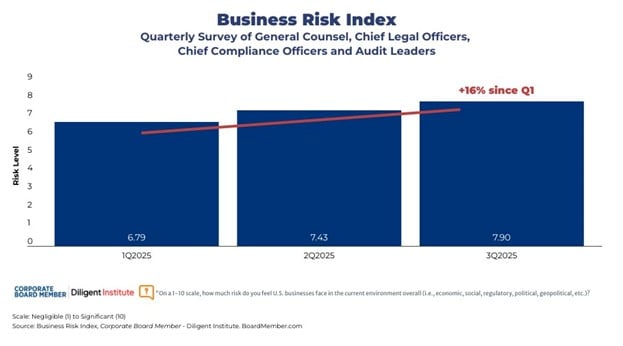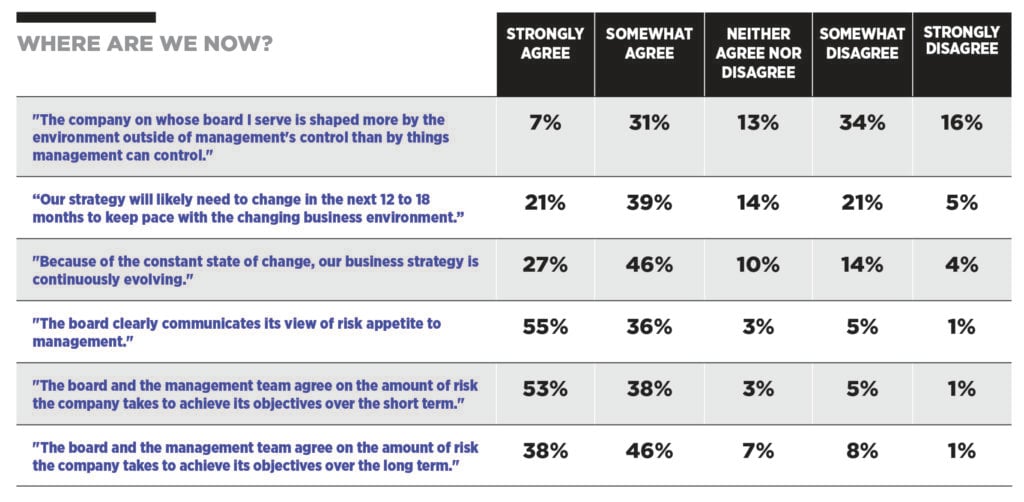Strategy Shapers
Looking ahead at elements likely to influence strategy in 2022, 50 percent of directors participating in this year’s survey cited the economy, inflation levels unseen in decades and potential Fed tapering. Many, however, are less concerned about economic growth than the ongoing supply chain issues plaguing businesses.
Although there are some early indications that the supply chain is easing, “we have yet to see the costs of a freight transport drop,” says Kathleen Camilli, board member at Toronto-listed AGF Management and NYSE-listed UniFirst Corporation, who serves on the audit and compensation committees. “So that’s the top-of-mind issue for us. It’s a big, big problem. It’s also a big problem that there’s a labor [shortage] in the ports and the unloading of the ships, and then getting the goods from the ships onto the rail to the location. It’s been extremely challenging this year, and I don’t see it really going away.”
The disruption has led companies to weigh a bigger-picture supply chain question, she notes: “Do you want to bring it closer to home?”

Cyber & Talent Top Concerns
Boards have been tackling an unprecedented range of issues for the past couple of years. From a global health pandemic, coping with the Great Resignation and growing stakeholder pressure for corporate accountability to a changing regulatory landscape and a drastic shift in customer behavior and tech-fueled innovation, there’s no shortage of items on today’s agendas.
Which ranks most highly on the list of issues keeping directors up at night today? According to our survey of 400 U.S. public company board members, it’s a near-tie between cybersecurity (41 percent) and talent (38 percent). Long among the top director concerns, cybersecurity jumped from third place last year to claim the top spot.

“[Cybersecurity] is a topic in every board meeting,” says Robert Shapiro, a director of the board of Overstock.com and a former advisor to top White House officials, including President Bill Clinton, Vice President Al Gore and Secretary of State Hillary Clinton.
Heightened awareness of the need for a multifaceted cybersecurity strategy is fueling the sense of urgency, he explains. “Most people focus on preventing attacks. Well, you can’t prevent all attacks. What you need to focus on is not as much prevention or protection as resilience, how quickly you get back up…. Anybody can be taken down, but the question is, can you get back up in 15 or 30 or 60 minutes—or a catastrophic two or three days?”
As criminals in the world of cyber evolve, so must mechanisms for defending organizations against that activity, adds John Hayden, director on the boards of the E. W. Scripps Co. and Tiberius Acquisition Corporation. He says the board’s role to keep asking who, what, when, where and why— questions that challenge management to think at the next level.
“Boards need to continue to say, ‘Okay, what’s new in this arena? What are we likely to see next? How can we best look around the corner and try to position ourselves to defend effectively against it?’” he says.
Directors also need to be cautious, as they can be among the most vulnerable to attacks, points out Scott Gibson, a director on the boards of Northwest Natural Gas Company and Pixelworks. “Some of them wouldn’t have the slightest clue whether or not their router has a password,” he says, noting that board members often resist implementing cybercrime preventive measures they perceive as invasive. “I don’t think people appreciate that it only takes one weak link if the bad guys figure it out, and remote work because of poor router protection is rife with opportunity for the right bad guys.”
While boards typically bring in outside expertise to assist in their cybersecurity oversight, Herman Bulls, who sits on the boards of Host Hotels & Resorts and Comfort Systems USA, says having directors with cyber as a core competency is helpful, “because they know how to appropriately articulate the issues, the risks and the possible mitigating factors.”
Talent, meanwhile, is a new contender topping the list of issues keeping directors up at night. Talent issues—lack of skilled labor, shifting of work policies, Covid-related mandates, rising wages, etc.—are affecting companies’ ability to execute on growth strategies amid strong pent-up demand.
“Everyone’s losing talent, no matter how good your culture, policies or pay packages,” says Gibson. “The velocity of change is unprecedented, and expectations are so much higher in terms of freedoms and allowances and work-from-home percentages, vaccination policies, to go down the list of complicating factors. Then [for] some jobs you really want people in the office more, some you don’t. So again, there’s a complexity that’s affecting talent. It’s a really, really challenging time.”
Camilli says this is a topic that’s discussed at every board meeting. “Our turnover has gone up to 70 percent for our line workers,” she says, noting that Amazon or Walmart set the bar for the country in terms of wages, and the environment has become much more competitive. “You have to [increase wages], because you can’t run a company without labor.”
Gibson says this highly competitive environment is also causing companies to make “more hiring mistakes than they have when they had some physical connection”—which he likens to conducting M&A in a virtual setting. “Maybe there’s a desperation element that makes that batting average worse in the pandemic in terms of colossal mistakes on talent.”
The Culture Dilemma
Culture has consecutively ranked as a challenging issue for directors to oversee, and it was awarded third position on the list for 2022. Its consistent ranking in our list can perhaps be attributed to the difficulty many directors report in assessing and overseeing culture. While 12 percent of directors say they’re fully confident in the reliability of the tools and resources at their disposal to oversee culture, nearly as many (11 percent) say they’re doubtful or uncertain.

Still, 49 percent report significant confidence in their culture oversight tools and resources, suggesting that most directors feel comfortable with the measures at their disposal. Camilli, for instance, says she hasn’t found the issue particularly challenging to oversee, yet acknowledges that employee surveys can often be inadequate “in terms of really getting a sense of what people are thinking.” Despite that potential gap, 49 percent of board members in our survey say they find employee surveys to be the most reliable way to oversee culture— well ahead of any other method.
Some directors, however, find combining multiple measures most effective. “The more ways you can assess culture, the better, as one reading of culture can be calibrated by or informed by another technique,” says Jan Estep, director at ACI Worldwide.
Bulls advocates for direct engagement between board members and employees. “I think for any board it’s important to make sure that you are seeing people other than the C-Suite,” he says, noting that his board periodically invites employees to board meetings. “Number one, it gives you an opportunity to see that next level of talent. Number two, believe it or not, it’s a big deal for people to come meet the board. So, it’s also a motivating factor for the employee.”
Bob Ducommun, director of Ducommun, a Tier 1 supplier in the aerospace sector, echoes the value of one-on-one meetings. “We try to have some of our annual slate of board meetings at various facilities around the country, and part of the schedule is dedicated to meeting and interacting with our employees, sometimes just by walking around,” he says. “It gives us the opportunity to meet with some truly impressive leaders, and with employees who in many cases have been with the company for decades.”

Front and Center: M&A Ops
M&A ranked as the most prominent topic on board agendas in 2022—suggesting that deal-making opportunities are a post-pandemic focus for companies—trailed closely by talent, at 45 and 44 percent respectively.
Several directors reported difficulty finding acquisition opportunities at reasonable prices in the current environment. Yet, acquisitions remain a critical growth strategy for companies like Ducommun, an aerospace manufacturer striving to strengthen its value to customers in terms of capability and scale. “To get there, we will continue to make selective acquisitions that supplement organic growth,” says Ducommun.
While Shapiro also anticipates robust M&A activity, he sees greater opportunity on the sell side. “The market is supported by the enormous credit bubble. That doesn’t mean it’ll burst, but it means you need to go way underneath the financials in order to understand what it is you’re buying or… the price that this inflated market has produced.”

Crisis Vulnerability
Given the supply issues so many companies are struggling with, it’s not surprising that supply chain disruption ranked second, behind cybersecurity, in vulnerability to crisis. Forty-six percent of directors rated it the area where they’re most concerned about confronting a crisis.
Few companies had the foresight and wherewithal to create contingency plans for the current disruptions, notes Gibson. “The rapidity of demand nearly ceasing to exist in March of 2020 to suddenly exploding in certain areas like supplying work-from-home needs, everything from furniture to PCs—I can’t imagine how someone could have anticipated that,” he says.
Those who did, however, benefitted. Ducommun recounts an overhaul of its supply chain agreements a few years before the pandemic hit. “We reduced the number of critical suppliers significantly,” he says. “When combined with the aggregation of our purchasing power across the enterprise, that rationalization resulted in a commitment to place much more of our business with those that survived that process.” The company was able to set clear expectations on pricing, availability and delivery, with the understanding that suppliers who perform will earn larger chunks of its business.
And therein lies the lesson. “The truth is the companies that do best at this are the ones that had been thinking about these issues before this arose,” says Shapiro. “They already had the personnel, and they know how to approach these issues. Like the way we deal with cyber. You have a plan.”

Assessing ESG Excellence
Several years of initiatives aimed at bringing greater diversity to boardrooms seem to have paid off, with 79 percent of directors reporting that their boards have met or are on track to meeting their diversity goals.
“While accomplishing your diversity goals in a short amount of time is a good thing, the journey should continue from those initial successes,” says Kira Ciccarelli, lead research specialist at the Diligent Institute. “No respondents indicated they had a timeframe of more than five years to meet diversity goals, which would be the first step to thinking about DEI as part of long-term strategy.”

What’s more, industry expertise and leadership experience are now back at the top of the list of attributes boards are now seeking in their next director appointment—a shift from last year’s top three criteria of background, racial and gender diversity last year. Anecdotally, directors say they have the diversity they need at this time and are therefore focusing on onboarding certain missing skillsets.

Data from the survey also shows a slight uptick in the integration of ESG considerations into corporate strategy. Thirty-nine percent of directors say their boards decided to move forward with tying exec comp to environmental metrics—up from 26 percent just a year ago, when we asked directors whether environmental issues were informing their executive pay programs.
Similarly, 40 percent are doing the same with respect to social considerations. Part of the challenge that remains, directors say, is lack of guidance or standardization.
Hayden, whose board is already tying social metrics into executive compensation, reports: “Hard metrics are very difficult in this arena because I think that’s where it can become counterproductive. In our case, the evaluation is subjective, not an objective approach, so it’s a modifier in the equation as opposed to an arithmetic element of the equation.”

One of Gibson’s boards is a fossil fuel distribution company that has set 2050 carbon neutrality goals but does not tie those goals into executive compensation formulas. “No one is a climate change skeptic, but how does it get measured?” he asks. “No company can fill out 13 different forms and 13 different frameworks. And to put it in executive comp before these frameworks are solidified and condensed? I think that that hesitation is just saying, ‘Well, let’s wait until this congeals. And then we can put it in the executive comp system, but right now, what would we put in there? We’d put in a framework that might become obsolete.”
Although Bulls’ board isn’t tying these issues into executive compensation, he says when it comes to setting metrics, it’s up to the board to determine precisely what the targets are and then to hold management accountable for meeting these milestones.
“What are the objectives you want to accomplish? And why is that important?” he says. “There is an opportunity for senior management to look at their teams and decide how they will prepare to compete for the future. And the most important thing around that is understanding the business imperative and helping everybody on the team understand the why—why is this important?”







